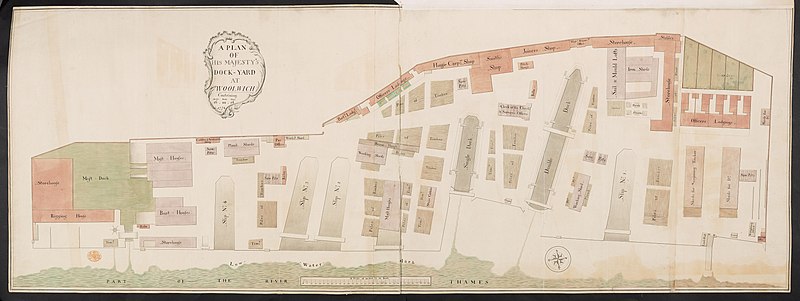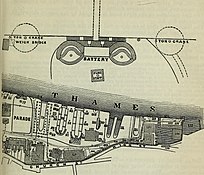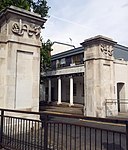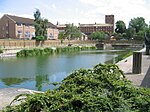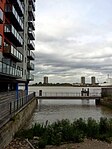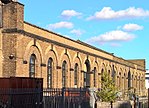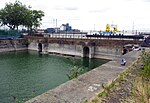Woolwich Dockyard
| HM Dockyard, Woolwich | |
|---|---|
| Woolwich, NW Kent | |
 Clock House (Dockyard offices, 1783–1784), the earliest surviving building on the Woolwich Dockyard site) | |
| Coordinates | 51°29′40″N0°3′22″E/ 51.49444°N 0.05611°E |
| Site information | |
| Operator | Royal Navy |
| Controlled by | TheNavy Board(until 1832); theAdmiralty(1832–1869). |
| Other site facilities | The Gun Wharf, The Ropeyard and The Steam Factory |
| Site history | |
| In use | 1512–1869 |
Woolwich Dockyard(formallyH.M. Dockyard, Woolwich,also known asThe King's Yard, Woolwich) was an Englishnaval dockyardalong the riverThamesatWoolwichin north-west Kent, where many ships were built from the early 16th century until the late 19th century.William Camdencalled it 'the Mother Dock of all England'.[1]By virtue of the size and quantity of vessels built there, Woolwich Dockyard is described as having been 'among the most important shipyards of seventeenth-century Europe'.[2]During theAge of Sail,the yard continued to be used for shipbuilding and repair work more or less consistently; in the 1830s a specialist factory within the dockyard oversaw the introduction ofsteam powerfor ships of the Royal Navy. At its largest extent it filled a 56-acre site north of Woolwich Church Street, between Warspite Road and New Ferry Approach; 19th-century naval vessels were fast outgrowing the yard, however, and it eventually closed in 1869 (though a large part of the site remained in military hands for a further century). The former dockyard area is now partly residential, partly industrial, with remnants of its historic past having been restored.
History[edit]
Origins[edit]
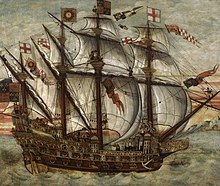
Woolwich Dockyard was founded by KingHenry VIIIin 1512 to build hisflagshipHenri Grâce à Dieu(Great Harry), the largest ship of its day.[3]The ship was built inOld Woolwich,which is where the dockyard was initially established: past Bell Water Gate, east of the area later known as Woolwich Dockyard. The site consisted of one or more rudimentarydry docks,a long storehouse (for canvas, rigging and other materials) and a small assortment of other buildings. Like its counterpartDeptford Dockyard,Woolwich was probably chosen for its position – on the south bank of the tidalRiver Thamesconveniently close to Henry's palace atGreenwich– and for its proximity to deep water. Several other ships were built here afterGreat Harry,but in the 1520s shipbuilding appears to have ceased (the site may have been prone to flooding, a problem that caused the closure of another Royal Dockyard further downstream inErithat around this time). By 1540, however, the royal shipwrights had begun operating on higher ground further to the west at what was to become the permanent site of the Dockyard, where a pair of dry docks (alreadyin situand known as "Boughton's Docks" ) formed the centre of operations. The site was purchased by the Crown in 1546 and in the second half of the century several sizeable ships were built there. The yard was also used for heavy repair work.[2]
Early history[edit]

The two dry docks were rebuilt in the early 17th century (the first of several rebuildings) and the western dock was expanded, enabling it to accommodate two ships, end to end. In the years that followed, the dockyard was expanded; its facilities includedslipwaysfor shipbuilding, timber yards,saw pits,cranes,forges,a mast house and severalstorehouses.There were also houses on site for the senior officers of the yard. A clock house was built in 1670 (containing amould loftfor drawing up full-scale ship designs) and in 1698 a palatial Great Storehouse was erected. Apart from the brick-built mast house and Great Storehouse, the buildings were almost entirely of timber construction.[2]
The Gun Wharf[edit]

As at other Royal Dockyards, theOrdnance Officemaintained a Gun Wharf at Woolwich for storage and provision of guns and ammunition for the ships based there. The Gun Wharf was sited east of Bell Water Gate (where there is now a car park next to the Waterfront Leisure Centre). It was here that Woolwich Dockyard had been founded in 1512 and the Great Harry was built in 1515; when the dockyard had moved to its new, permanent site in the 1540s, the old wharf, crane and storehouse had been given over to storage of heavyordnanceand other items. Gun carriage repair was also undertaken on site. Later, use of the Gun Wharf was shared with the nearby Royal Ropeyard, which maintained a storehouse there for hemp and other materials. The wharf and its buildings were improved and rebuilt at regular points through the 16th and 17th centuries; as late as 1664 a large new brick storehouse was provided "to lodge ships' carriages in".
The wharf was still subject to frequent flooding, however, and from the 1650s the Board of Ordnance began to make use of open land at Tower Place, to the east of the Gun Wharf, as a site forprovingand storing cannons and other large guns. Known as 'The Warren', this was the beginning of what would later become the WoolwichRoyal Arsenal.The Ordnance Office withdrew from Gun Wharf in 1671, but the Ropeyard continued to make use of the wharf and its associated storehouses into the 19th century.
The Ropeyard[edit]

In the 1570s the Crown established a navalRopeyardin Woolwich, one of the largest in the world at the time. Too long to fit within the confines of the Dockyard, its parallel sheds lay along the line of present-day Beresford Street. As first built it consisted of a 600 ft 'cable house' along with a series of sheds accommodating different parts of the rope-making process. In 1695–1697 the ropeyard was largely rebuilt, under the supervision ofEdmund Dummer;by the end of the century it included a double-ropewalk, 1061 ft long, a parallel single-ropewalk of similar length, a brick storehouse with a clock tower, houses for the yard's senior officers and various other buildings, all enclosed within a perimeter wall topped bywatchtowers.[2]Parts of the yard had to be rebuilt after a fire in 1759, and again after another fire in 1813. The ropeyard remained in service until 1832, by which time similar establishments in other Royal Dockyards had begun to come to the fore; the site having been sold in 1833, its buildings were demolished soon afterwards, in 1835.[4]
Second golden age[edit]

The fortunes of the yard had waned toward the end of the seventeenth century; in 1688 its work was valued at £9,669, in contrast to nearby Deptford (£15,760), not to mention the (by now much larger) Royal Dockyards at Portsmouth (£35,045), and Chatham (£44,940).[2]In the first half of the eighteenth century, however, it gained a renewed momentum: the site doubled in size, as did the workforce, and even in the first decade of the 1700s there were more ships launched from Woolwich than from any other English yard. Many buildings were built (or rebuilt) at this time, now mostly in brick. On newly acquired andreclaimedland to the east, three new slips were built and a new mast pond was created, along with adjacent mast houses and boat sheds; a sizeablerigginghouse was also built here. Alongside the Great Storehouse an equally large building, housing both a sail loft and a mould loft, was constructed in 1740. Meanwhile, land acquired to the west enabled a new terrace of officers' houses to be built in the early 1750s.

The yard was further expanded westwards in the 1780s, again almost doubling in size. Much of the area of the expanded dockyard was preserved as open ground for storage of timber, with rows of woodenseasoningsheds; as the Navy's ships were growing in size and number, more raw materials were needed across the Royal Dockyards. Two new mast ponds were constructed, replacing a pond at the eastern end of the site which dated from 1720 but was now considered too small (the new ponds and mast houses could accommodate mast lengths of up to 120 feet (37 m)); the old pond, together with its associated buildings, was now given over to the construction and storage ofship's boats.Centrally positioned in the expanded yard, a new clock house was built, containing offices for the various departments of the dockyard, and with it a new main gateway (replacing the old entrance which had been located further to the east).

Later, Shipbuilding continued in earnest during theNapoleonic Wars;but, as ships grew still bigger, the Thames continued to silt up. In 1800Samuel Bentham,theInspector-General of Naval Works(who had himself served as anapprenticeshipwrightat Woolwich in the 1770s) proposed replacing Woolwich,Deptford,ChathamandSheernessdockyards with a single new facility on theIsle of Grain;but this, (along with other radical proposals) was not pursued. In 1802 a steam-drivenbucket dredgerwas brought into service at Woolwich (prior to this, convicts had been used to dredge the quayside by hand) but still the silting persisted; nevertheless, the yard continued to be developed: in 1814 a large smithery ormetal-workingfactory was added to produceanchorsand other iron items. In the 1820s two new covered slips were added (No.1 and No.2 Slips) large enough to accommodate the latest ship designs. The following decade a substantial part of the river wall was rebuilt in brick and the two dry docks were reconstructed in granite in the 1830s–40s. Alongside the docks a steam-poweredsaw-millwas provided, a new workshop withsteam hammersand a hydraulic chain and cable testing facility.
The Steam Factory and last years of the Dockyard[edit]
From 1831, Woolwich found a new lease of life as a specialist yard formarine steam engineering(a relatively new technology which was being developed commercially at nearbyMillwall). New buildings were constructed on the site for steam manufacturing and maintenance, including a boiler shop for manufacturing boilers, foundries for brass, copper and iron work, and an erecting shop for assembling the steam engines; by 1843 all were integrated into a single factory complex, with a single large chimney drawing on all the various forges and furnaces by way of underground flues.[5]Integral to the creation of the steam factory was the conversion of two mast ponds (which lay to the north of what is now Ruston Road) intosteam basins,where ships could moor alongside the factory while their engines and boilers were fitted. One of these basins was provided with its own dry dock (No. 1 Dock) which, like the basins, was filled in and built over in the 20th century. The factory was part of the dockyard, but had a high degree of independence: it was accessed by its own gate (known as the West Gate or Steam Factory Gate) and overseen by its own official, the Chief Engineer.

Woolwich retained its primacy as the Navy's steam engineering yard through the 1840s, but following the establishment of large-scale steam yards atPortsmouth(1848) andDevonport(1853) it became increasingly redundant, especially as its basins were no longer large enough for the size of ships now being built. Older ships still came to Woolwich for engine repairs and maintenance, but by the end of theCrimean Warthe steam factory's days were numbered. Surprisingly though, the dockyard had managed to remain active in shipbuilding and its facilities continued to be upgraded and expanded through the 1850s and early 1860s; during that time a newrolling milland anarmour plateshop were built as well as a sizeable new sail loft and rigging store. Ultimately, though, the yard could not keep pace with the emerging needs of the newironclad warships,and by 1865 it was clear that both Woolwich and Deptford Dockyards were destined for closure.[2]
Administration of the dockyard[edit]

From 1630 until 1688 the Master Shipwright was the key official at the dockyard until the introduction of resident commissioners by theNavy Boardafter which he became deputy to the resident commissioner. The Commissioner of the Navy at Woolwich Dockyard held a seat and a vote on the Navy Board in London. In 1748 the dockyard was managed directly by the Navy Board,. In 1832 the post of commissioner was replaced by the post of captain-superintendent, who was invested with the same power and authority as the former commissioners, "except in matters requiring an Act of Parliament to be submitted by the Commissioner of the Navy". On 5 September 1971 all Flag Officers of the Royal Navy holding positions of Admiral Superintendents at Royal Dockyards were restyled as Port Admirals.
Master shipwright, Woolwich Dockyard[edit]



Post holders included:[6]
- Peter Pett,1630–1652
- Christopher Pett,1652–1668
- Jonas Shish, 1668–1675
- Phineas Pett,1675–1678
- Thomas Shish, 1678–1685
- Joseph Lawrence, 1686–1697
- Samuel Miller, 1697–1699
- William Lee, 1700–1701
- Joseph Allin, November–March 1705
- Richard Stacey, 1705–1709
- Jacob Ackworth, 1709–1714
- John Naish, 1714–1715
- John Hayward, 1715–1727
- John Hayward, 1727–1741
- John Holland, 1742–1745
- Thomas Fellowes, 1746–1752
- Thomas Slade Thomas, May 1752 – June 1752
- Adam Hayes, June 1752 – February 1753
- Edward Allin, March 1753 – December 1755
- Israel Pownoll, December 1755 – May 1762
- Joseph Harris, June 1762 – May 1767.
- William Gray, July 1767 – July 1773
- Nicholas Phillipps, 1773–1778
- George White, January–April 1779
- John Jenner, April 1779 – December 1782
- Henry Peake, December 1782 – November 1785
- Martin Ware, December 1785 – March 1787
- John Nelson, March 1787 – March 1790
- William Rule, April–August 1790
- John Tovery, 1793–1801
- Edward Sison, 1801–1816
- Henry Canham, April 1816 – July 1826
- Oliver Lang, 1826–1853
- William M. Rice, April 1853–1859
- George Turner, July 1859–1866
[edit]
Post holders included:[7][8][9][10][11]
- Baltasar St Mitchell, 1688–1702
- Henry Greenhill, 1702–1744
- Thomas Whorwood, 1744–1745
- Edward Falkingham,1745–1746
- James Compton, 1746–1747
- William Davies, 1747–1748
Note: From 1748 to 1806 the yard was managed directly by the Navy Board. - CaptainCharles Cunningham,1806–1828(Charles Cunningham was also commissioner at Chatham in March 1828).
Captains and Commodores Superintendent, Woolwich Dockyard[edit]
Post holders included:[7][12][13][14][15][16][17][18][19][20][21][22]
- CaptainSamuel Warren,C.B., 1828–1838
- CaptainPhipps Hornby,C.B., 1838–1841
- Captain (Commodore from 1844) SirFrancis A. Collier,C.B., 1841–1846
- Commodore SirJames. J. G. Bremer,K.C.B., K.C.H., 1846–1848
- CommodoreHenry Eden,1848–1853
- Commodore John Shepherd, 1853–58
- Commodore the Hon.James Robert Drummond,C.B., 1858–1861
- Commodore Sir F. W. E. Nicholson,Bart,1861–1864
- Commodore Hugh Dunlop, C.B., 1864–1866
- CommodoreWilliam Edmonstone,1866–1869
Notable ships launched at the dockyard[edit]



- 1512–14 –Henri Grâce à Dieu(Great Harry); flagship of Henry VIII
- 1557–59 –Elizabeth Jonas(the Elizabeth); fought against the Armada in 1588; rebuilt in 1597–98; broken up in 1618
- 1586 –Vanguard– the first Royal Navy ship to bear this name
- 1608 –Ark Royal– a rebuilding
- 1610 –HMSPrince Royal
- 1613 –Defiance– a rebuilding
- 1615 –Merhonour– a rebuilding
- 1616 –HMSConvertine– originally begun as the private warshipDestinyforSir Walter Raleigh
- 1617 –Rainbow– a rebuilding
- 1631 –HMSVanguard– a rebuilding
- 1637 –HMSSovereign of the Seas;first-rateship of the line,ordered byCharles I
- 1655 –Naseby,later renamedHMSRoyal Charles
- 1658 –Richard,later renamedHMSRoyal James
- 1670 –HMSSaint Andrew;first-rateship of the line,later renamed HMSRoyal Anne
- 1701 –HMSRoyal Sovereign;first-rateship of the line
- 1751 –HMSDolphin;circumnavigatedthe globe twice
- 1756 –HMSRoyal George;first-rateship of the line;her sinking in 1782 was one of the worst disasters in Royal Navy history – around 800 lives were lost
- 1783 –HMSEuropa– 50 gunFourth-rate,used byJoseph WhidbeyandGeorge Vancouverto conduct a survey ofPort Royal, Jamaicain 1793
- 1805 –HMSOcean;second-rateship of the line,flagship ofLord Collingwood
- 1809 –HMSMacedonian;frigatecaptured byUSSUnited Statesduring theWar of 1812
- 1814 –HMSNelson;a 126-gunfirst-rateship of the lineof the Royal Navy
- 1818 –HMSTalavera;third-rateship of the line
- 1820 –HMSBeagle;ship used on naturalistCharles Darwin's famous voyage
- 1846 –HMSNiger,ship used for trials to prove the superiority of screw propulsion
- 1852 –HMSAgamemnon,the first British battleship to be designed and built from the keel up with installed steam power
- 1854 –HMSRoyal Albert,screw steamer with 131 guns
- 1868 –HMSRepulse,the last woodenbattleshipconstructed for the Royal Navy
- 1868 – HM Floating Dry Dock 8,200 tonnes [Constructed of iron for HM Dockyard Bermuda]
Closure and aftermath[edit]

Woolwich Dockyard finally closed in 1869;[23]however, although the easternmost part of the site was sold, everything west of No. 5 Slip (i.e. over 90% of the area) was retained by theWar Office[2](which continued to refer to it as 'Woolwich Dockyard' and 'Royal Dockyard, Woolwich' until relinquishing ownership of the site a century later).
The eastern area today known as Mast Quay was sold by auction in 1872. Royal Dockard Wharf was used by a timber and slate merchant, E. Arnold & Co, in the 1870s. By 1919, the site was occupied by W.R. Cunis Ltd, owners ofdredgers,tugsandbarges,which used the wharves and slips for repairing their vessels. Cunis later (1971) formed Cubow Ltd, a joint venture withHay's Wharf Ltd,to build boats, including substantial sailing vessels of up to 1,000 tons, a 1973 fishing trawler later chartered by theMinistry of Defencefor use as aminesweeper(HMSDavid), a cargo vessel (Ambience), theNaticia(a London leisure cruise boat) and theBeagle,still in use around theGalápagos Islandsin 2023. The area was last used for boat repair work in the 1990s.[24]
War Office use of the site[edit]
After closure, much of the retained land went on to be used as storage space for theOrdnance Stores Department,based at the nearby Royal Arsenal; general items (includingbarrackstores,accoutrementsandharness) were moved to the Dockyard, while 'warlike stores' remained in the Arsenal. Warehouses were built across much of the site and existing buildings were converted to provide storage space; there were also workshops on site for manufacturing harnesses, saddlery and the like.[25]A railway system served the complex, part narrow-gauge, part standard-gauge, the latter linked (by way of a tunnel under Woolwich Church Street) to theNorth Kent Line(which was in turn linked into theRoyal Arsenal Railway). The tunnel remainsin situfor use by pedestrians. The dockyard church was used as a garrison chapel by the infantry quartered nearby inCambridge Barracks.[26]
From 1878 part of the Dockyard was given over for theCommissariatReserve Stores; over the next decade it became the main supply depot providing food andforagefor overseas garrisons andexpeditionary forces.[27]During theSudan Campaigna very large forage store was built on the site, with hydraulic equipment for compressing and bailing hay. Briefly, from September 1888, theCommissariat and Transport Corpshad its Regimental Headquarters in the Dockyard, but the following year the corps became theArmy Service Corpswith its headquarters in Aldershot.[28]
In 1889 anInspectorateof Royal Engineer Stores (IRES) was established at Woolwich Dockyard (an early example of independentquality assurance), which had 'custody of a complete set of sealed patterns for all items of Royal Engineer equipment' and responsibility for 'the preparation of detailed specifications to govern manufacture'.[29]It remained based in the Dockyard,[30]and was later renamed the Inspectorate of Engineers and Signal Stores (IESS) in 1936, and the Inspectorate of Electrical and Mechanical Equipment (IEME) in 1941. The Chief Inspector of General Stores (later styled Chief Inspector of Equipment and Stores) was also based there from the 1890s, as was the Superintending Engineer and Constructor of Shipping (who supervised, across various different shipyards, the construction of vessels for theWar Department Fleet).[31]

During theFirst World Warthe dockyard remained operational as an Army Ordnance Depot and ASC Supply Reserve Depot.[27]It also accommodated the country's largestArmy Pay Office,[32]the headquarters of the War Office Inspection Department,[33]and the Records Offices of the Army Service Corps and the Army Ordnance Corps.[34]
Following the outbreak of the Second World War, stores and facilities were removed from Woolwich Dockyard in an attempt to protect them fromaerial bombardment.Later on, military activity resumed in the Dockyard: from 1942 it served as a Central Repair Depot of the Royal Army Ordnance Corps,[35]and at the same time the Royal Army Service Corps established its main Boat Stores Depot there.[36]In time, the repair function of these corps was taken over by theRoyal Electrical and Mechanical Engineers.
Gradual military withdrawal[edit]
In 1926 the western part of the site was sold to theRoyal Arsenal Co-operative Society;the Co-Op still occupies a number of buildings on the site. The older, eastern portion of the site remained inMinistry of Defencehands, used for storage, workshops and offices, until the closure of the Royal Arsenal in the 1960s.[37](TheRoyal Electrical and Mechanical Engineers,one of the last military units on site, moved out in 1966, taking with them themuster-bell and mast that had stood inside the main gate; it was re-erected at theirdepotatArborfield,where it was rung for church services;[38]in 2016 it was scheduled to move with the corps to their new headquarters atMoD Lyneham.)[39]
Redevelopment[edit]
Thereafter the older part of the dockyard was turned into a housing estate byGreenwich London Borough Councilin the early 1970s. In the 1980s and 90s theThames Pathwas extended to the area. Various housing projects have encroached on the historic character of the area. Two towers with luxury apartments were built at Mast Quay around 2005, with even taller towers being projected in 2015.[2]The second phase of Mast Quay was completed in late 2022 and comprised towers of 23, 11, nine and six storeys, but differed markedly from what had originally been proposed. The developer,Comer Homes Group,proposed revisions to the design in December 2022 when construction was nearly finished.[40]However, the build-to-rent development had "26 main deviations to the original planning permission" granted in 2012, and in September 2023, Greenwich Council ordered Comer Homes to demolish the blocks.[41][42]Comer said it would appeal against the enforcement notice.[43]
Heritage[edit]

On Woolwich Church Street, a late 18th-century guard house and police office with neoclassical features stand alongside the former dockyard gates. Nearby, the former dockyard administration building now serves as the Clockhouse Community Centre; it dates from 1778 to 1784.[44]Closer to the river, a couple of closed off docks have been preserved (and partly rebuilt) as a reminder of the area's marine significance. Two shipbuilding slips have also survived, either side of the new Mast Quay apartment blocks, and a pair of antique guns have been mounted on the quayside where a Royal Marines gun battery formerly stood.[2]

Surviving industrial buildings include parts of the old factory wall along Woolwich Church Street and remnants of the Steam Factory with its prominent chimney nearby. The original factory building of 1838 still stands on the south side of Ruston Road, although only at around two-thirds of its original length of 444 feet (135 m). When built, it housed a complex of boiler shops, a foundry, fitting shops and erecting shops for the manufacture and assembly of marine steam engines. Additions were made over the next ten years, culminating in the smithery which stands parallel with the original block, to the south; dating from 1847, this originally contained 48 hearths and 5Nasmythsteam hammers. Coppersmiths and brass founders were accommodated in a smaller block just to the west (which is still to be seen, immediately north of the old police house at the West Gate). The building which faces the police house across the gateway was built in 1848–49 to serve as the Woolwich Dockyard School for Apprentices: one of a number of such schools set up at the Royal Dockyards under an Admiralty Scheme of 1843, Woolwich specialised in steam engineering, and for a time factory apprentices from all the royal dockyards were educated at the school.[2]
Less than half amileto the south of the site there is arailway stationcalledWoolwich Dockyard.
Relocated buildings[edit]

An iron-framed building of 1814 byJohn Rennie the Elder,removed from Woolwich in the 1970s, was re-erected atIronbridgewhere it houses theBlists Hill foundryexhibit; in the dockyard it had housed Rennie's anchor forge, which was notable as the first industrial use of steam power in any naval establishment (other than for pumping water).[5]

A number of metal roofs, built over shipbuilding slips at Woolwich in the 1840s and 1850s, were dismantled after the Yard closed andrebuilt at Chathamto house various manufacturing processes:
- The earliest, constructed byFox, Henderson & Coin 1844–45, remains one of the oldest surviving examples of a wide-spanmetal framestructure (of a form later destined to become familiar in the construction oftrain shedsand similar buildings). Originally built over No. 7 Slip (renumbered as No. 6 in the 1850s), the structure was dismantled after the closure of the dockyard and rebuilt at Chatham to serve as amachine shop.[2]
- Another, built over No. 4 Slip in 1846–47, was also by Fox and Henderson but of a much more sophisticated design (as well as being larger and more robust). Moved to Chatham in 1876, it served to house the mainboiler shopfor the steam factory there. After standing empty for many years it was restored in 2002–03 to serve as the main mall of Chatham's Dockside Outlet shopping centre.[45]
- A third slip cover, manufactured byHenry and Martin Grisselland erected over the new No. 5 Slip in 1856–58, was also moved to Chatham in the 1870s, where it went on to serve as the main Engineering Factory of the expanded dockyard. Unlike the earlier two examples it was subsequently demolished (in around about 1990).

The Dockyard Church, designed byGeorge Gilbert Scottand dating from 1856 to 1858, had formerly stood just inside the main gate to the Dockyard. It had seating for 1,200 worshippers and was designed to accommodate not only the resident officers and workers of the yard but also the Woolwich Division of the Royal Marines. After a period of disuse it was dismantled and rebuilt in 1932 inEltham(where it remains in use as St Barnabas's Church).[2]
Gallery[edit]
-
Clock house (1783) as seen from the main gate
-
Main Gate (1784)
-
Guard house and Master Warders's lodgings (1788–89)
-
Gun battery (1847, rebuilt 1976)
Docks and slips[edit]
-
No. 2 Dock (rebuilt 1838–41)
-
No. 3 Dock (rebuilt 1844–46)
-
No. 5 Slip (rebuilt 1855–56)
-
No. 6 Slip (1728, later rebuilt and extended)
Steam factory site[edit]
-
Steam Factory: the former erecting shop (1838)
-
Steam Factory: the former brass foundry (1846) with the smithery beyond
-
Steam Factory: the former smithery (1846)
-
Factory wall (rebuilt c. 1840)
-
Police Station alongside the West Gate (1846)
-
Woolwich Dockyard School for Apprentices (1848–49)
Later development[edit]
-
1970s housing estate
-
Mast Quay development (2004–06)
-
TheThames Pathin Woolwich Dockyard
-
Fishing in a former dry dock
References[edit]
- ^Hogg, Brigadier O.F.G. (1963).The Royal Arsenal Woolwich.Vol. I. London:Oxford University Press.
- ^abcdefghijklmSaint & Guillery,The Survey of London vol. 48: Woolwich,Yale, 2012.
- ^Woolwich,Encyclopædia Britannica Online Library Edition, 2010
- ^Timbers, Ken (2011).The Royal Arsenal, Woolwich.London: Royal Arsenal Woolwich Historical Society.ISBN978-0-9568614-0-5.
- ^abEnglish Heritage Survey of the Naval Dockyards
- ^Harrison, Simon."Master Shipwright at Woolwich Dockyard".threedecks.org.S. Harrison, 2010–2018.Retrieved27 June2018.
- ^abHarrison, Simon (2010–2018)."Woolwich Dockyard".threedecks.org.S,. Harrison.Retrieved4 January2019.
- ^Clowes, Sir William Laird (1897–1903).The royal navy, a history from the earliest times to the present Volume II.London: S. Low Marston. p. 231.
- ^Clowes, Sir William Laird (1897–1903).The royal navy, a history from the earliest times to the present Volume III.London: S. Low Marston. p. 4.
- ^Clowes, Sir William Laird (1897–1903).The royal navy, a history from the earliest times to the present Volume IV.London: S. Low Marston. p. 152.
- ^Clowes, Sir William Laird (1897–1903).The royal navy, a history from the earliest times to the present Volume V.London: S. Low Marston. p. 5.
- ^Admiralty, Great Britain (March 1828).The Navy List.London: John Murray. p. 121.
- ^Admiralty, Great Britain (March 1834).The Navy List.London: John Murray. p. 136.
- ^Admiralty, Great Britain (March 1835).The Navy List.London: John Murray. p. 135.
- ^Admiralty, Great Britain (November 1840).The Navy List.London: Simpkin Marshall and Co. p. 135.
- ^Admiralty, Great Britain (August 1841).The Navy List.London: Simpkin Marshall and Co. p. 265.
- ^Admiralty, Great Britain (August 1843).The Navy List.London, England: Simpkin Marshall and Co. p. 263.
- ^Admiralty, Great Britain (February 1844).The Navy List.London: Simpkin Marshall and Co. p. 263.
- ^Admiralty, Great Britain (December 1847).The Navy List.London: Simpkin Marshall and Co. p. 236.
- ^Admiralty, Great Britain (December 1848).The Navy List.London: John Murray. p. 173.
- ^Admiralty, Great Britain (December 1852).The Navy List.London: John Murray. p. 185.
- ^Bramble, James (1891).Promotion and Retirement of Flag Officers and Captains of the Royal Navy.Portsmouth: Holbrook & Son. p. 62.
- ^"The Royal Dockyards of Deptford and Woolwich".Retrieved21 August2012.
- ^Mills, Mary (4 October 2023)."Boatbuilding and the Cunis family".Greenwich Weekender.Retrieved4 October2023.,pp.10–11.
- ^"First or Woolwich Dockyard Division".Reports from Commissioners.30(17): 70. 1872.
- ^Atkins, T. (1883).Army & Navy Calendar.London: W. H. Allen. p. 158.
- ^abMacdonald, Janet (2014).From Boiled Beef to Chicken Tikka: 500 Years of Feeding the British Army.Barnsley, S. Yorks.: Frontline Books. p. 105.
- ^Crew, Graeme (1970).The Royal Army Service Corps.London: Leo Cooper Ltd. p. 81.
- ^Tricker, Ray (1991).Defence Electronics: Standards and Quality Assurance.Oxford: Butterworth-Heinemann. p. 168.
- ^"Royal Engineer Stores Inspection Department".The Monthly Army List:940. November 1934.
- ^Kneen, Brig. J. M.; Sutton, Brig. D. J. (1996).Craftsmen of the Army: The Story of the Royal Electrical and Mechanical Engineers (Volume II).London: Leo Cooper. p. 90.
- ^"The Army Pay Services on the Eve of the Great War".The RAPC Regimental Association.
- ^House of CommonsHansard,20 March 1917, volume 92 c. 591
- ^"Allies Here come the girls! The women volunteers at the Army Pay Office Woolwich from August to October 1914".Western Front Association.Retrieved16 September2016.
- ^Fernyhough, Brigadier A. H. (1967).History of the Royal Army Ordnance Corps 1920–1945.Royal Army Ordnance Corps. p. 421.
- ^The Story of the Royal Army Service Corps 1939–1945.London: G. Bell and Sons Ltd. 1955. p. 567.
- ^"Written answers, House of Commons 1964".Parliamentary Debates (Hansard).15 July 1964.Retrieved15 September2016.
- ^"Photo".Flickr.5 April 2015.
- ^"The move has started..."REME Museum.10 February 2017.
- ^Coughlan, Joe (17 February 2023)."Developers could be forced to change 'eyesore' South London tower block".MyLondon.Retrieved27 September2023.
- ^Booth, Robert (27 September 2023)."London apartment block that deviates from plans must be torn down, says council".Guardian.Retrieved27 September2023.
- ^Prior, Grant (27 September 2023)."Council orders developer to tear down tower blocks".Construction Enquirer.Retrieved27 September2023.
- ^Kelly, James (27 September 2023)."Woolwich: Developers ordered to demolish 'mutant' apartment blocks".BBC News.Retrieved27 September2023.
- ^Pevsner, The Buildings of England – London: South. Yale, 1983 & 2002.
- ^Wright, Joe (26 March 2020)."Photos show construction and the openings of Kent's shopping centres".Kent Online.Retrieved14 December2020.


